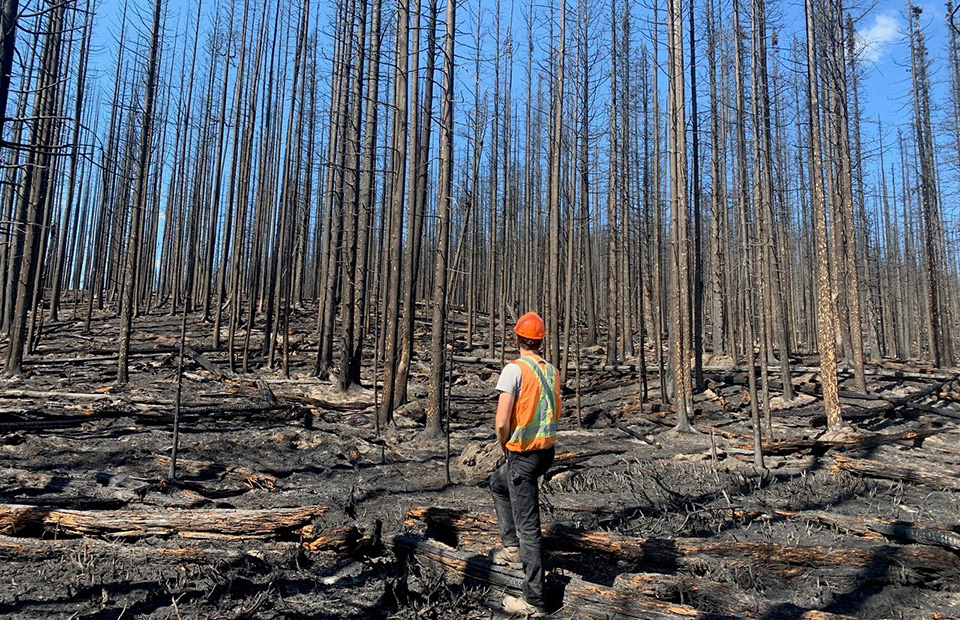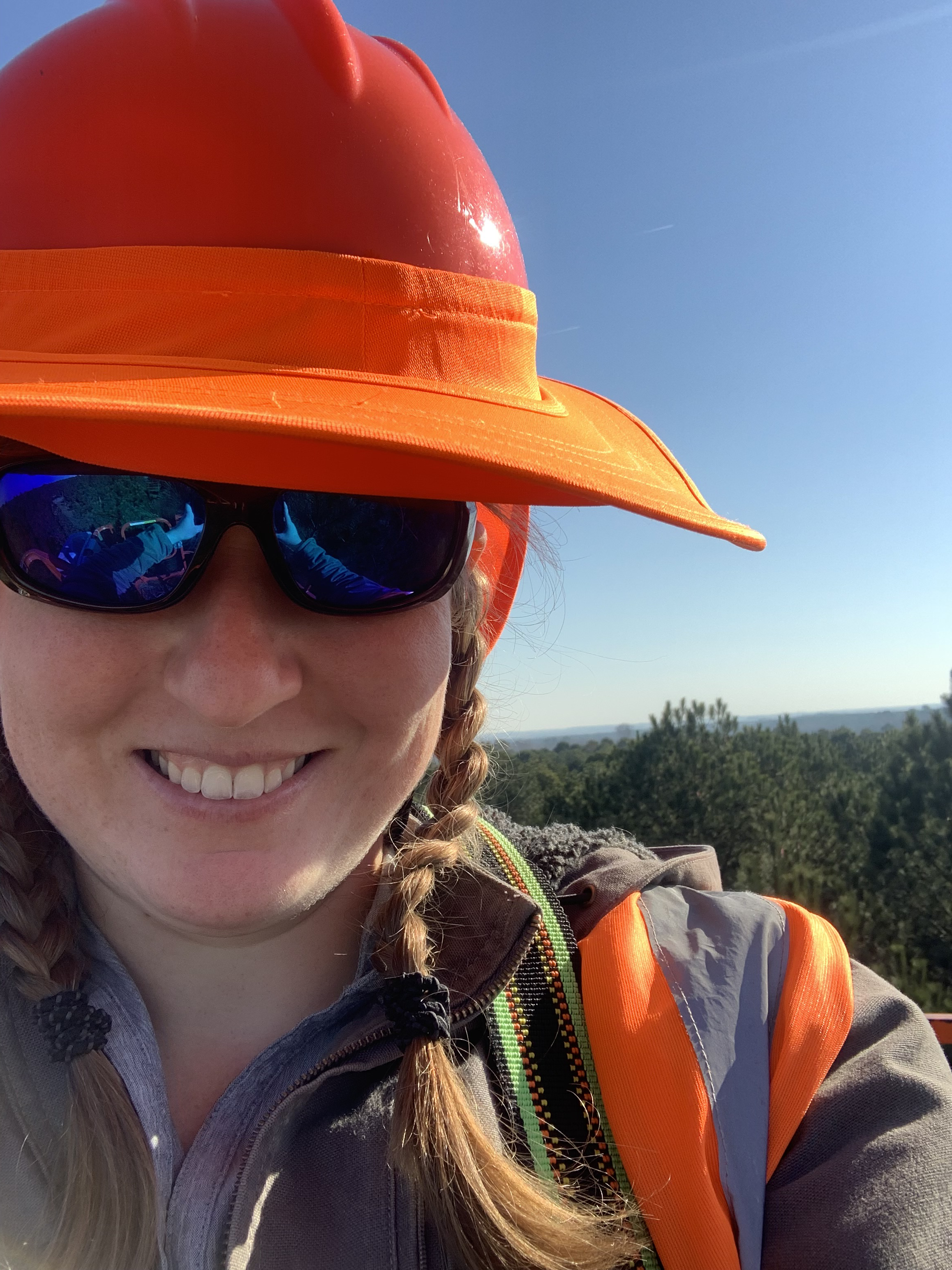
Since September, the Canadian Timberlands team has been working with the government and First Nations to salvage as much burned timber as possible.
On June 27, amidst a severe drought, British Columbia hit its highest temperature ever recorded: a scorching 121 degrees Fahrenheit (49.6 degrees Celsius). It didn’t take long for parched vegetation to go up in flames all over the southern half of the province, sparked by lightning or human activity.
Three major wildfires roared into the forests where we have harvest rights from the provincial government to supply our lumber mill in Princeton: Garrison Lakes, which encompassed 36,100 acres; Thomas Creek, which spread 25,962 acres; and Nk’Mip, clocking in at 47,470 acres (a total of 44,326 hectares).
“We halted active harvest, haul and silviculture operations as soon as the fire danger became high risk during the heatwave,” says Cory Yurkowski, operations superintendent. “Then we sprang into action to help the BC Wildfire Service, which was already stretched thin fighting hundreds of other fires. The fires threatened not just our livelihoods, but our communities.”
“There were days, especially at the beginning, when we were discouraged by the lack of headway,” Cory says. “A fire guard would burn through, we’d rebuild it and it would burn through again. We had to make hard calls, pulling back crews when conditions became unsafe. Helicopters weren’t always available to help. But we did our absolute best, and we’re all really proud of each other.”
TIMBERLANDS TAKES THE LEAD
The Princeton Timberlands team works with BC Wildfire Service to fight fires every summer, but 2021 saw a record number of intense fires breaking out all at once.
“We took a leading role, and every person on our team was involved at a moment’s notice,” says Norm Druck, Princeton Timberlands general manager. “The Garrison Lake fire started at 4 p.m. on July 23. Crystal Rogers, our fire preparedness coordinator, was out there flying the fire with BC Wildfire Service at 4:30 p.m., and machinery was actioning the fire by 10 p.m.”
For the Garrison Lake fire, Beth Anderson, logging supervisor, was brought in as plan section chief to work as a key member of the Incident Command Team, which included our employees, contractors, and staff from BC Wildfire Service. Beth helped track everyone who worked on the fire, put together daily plans for each unit crew, distribute maps made by our GIS specialists and interface with BC Wildfire Service and ministry officials. When conditions were safe enough, her crews fought the fires directly. Otherwise, they coordinated indirect attacks, anticipating where the fires were headed.
“We had to get started at the coolest part of the day — three o’clock in the morning,” Beth says. “We held safety meetings, established our control lines for the areas we were trying to protect, filled water trucks and organized the machinery. Our contractors did all the hardest work, using heavy equipment to remove brush and create fire barriers. Cory, Norm, myself and other supervisors coordinated and oversaw the process.”
By noon, when temperatures started getting dangerously hot, it was time to service the heavy machinery and leave the forest. But the work wasn’t over yet. Supervisors met with ministry contacts and discussed plans for the following day before heading home to rest.
CRUCIAL HELP FROM LOCAL LOGGERS
“Weyerhaeuser folks played an important role, but our contractors went above and beyond the call of duty,” Cory says. “They absolutely impressed us. Even on the hardest, most emotional days, we were joking and laughing, helping each other get through it. It made our bond stronger than ever.”
Shelby Smith, supervisor for Tri Valley Construction, has fought many fires in his 30 years working in the area. But this summer felt different, with danger advancing on so many fronts.
“To see it all go up in smoke was incredibly emotional for my team,” Shelby says. “Some of our guys have been working out here so long, they know exactly where the land drops off and where the fire guards should go. The Weyerhaeuser supervisors took our suggestions and had our backs 100 percent.”
Josh Wade, a supervisor for the WG Shaw & Son contracting firm who has a firefighting background, acted as operations chief for the Incident Management Team.
“I’ve been working with the Weyerhaeuser team since 2007, and our relationship was integral to this effort,” Josh says. “We had the level of trust you need to act quickly. The work we did with limited resources was truly amazing.”
Russel Turner, team leader of operations at the Fire and Rescue New South Wales Emergency Services Academy, was brought in to act as the logistics coordinator chief for the Incident Management Team. He was so impressed with Beth’s work he wrote her a letter of commendation. “It was no surprise to us, because Beth did a truly phenomenal job, and everyone noticed,” Cory says.
GRATITUDE IN THE HARDEST OF TIMES
By the time the fires were finally extinguished in early September, 20 Weyerhaeuser employees and 133 contractor employees from 30 firms had supported firefighting efforts, either working side-by-side with firefighters on the ground or coordinating efforts. And thanks to precautionary measures earlier in the fire season and some long-haul log purchase agreements, the Princeton mill never ran out of wood.
“Working 13- to 15-hour days for weeks on end during an acute emergency will wear anybody out,” Cory says. “But we didn’t have to ask people to come help us — we had to ask them not to come, because they needed to get some rest.”
All that hard work didn’t go unnoticed.
“Through generous acts, social media and newspaper articles, our community made it clear that it is very proud of our staff’s and contractor’s commitment and response,” Norm says.
The main grocery store in town, Save-On Foods, changed their sign along the highway to read “Thank you Weyerhaeuser and loggers.”
“At the end of one long day, a few of us stopped at a local diner,” Cory says. “A gentleman walked up to us and just said, ‘Thank you.’ Afterward we learned he paid our whole bill. Others donated lunches, water, Gatorade and other supplies to support our efforts. That sense of community support meant so much to us.”


